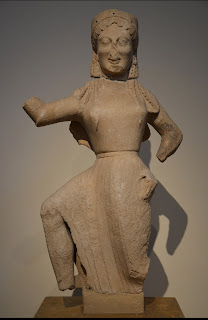In ancient Greek civilization, Nike (pronounced Naiki), or Victory was a goddess who personified victory. Her Roman equivalent was Victoria. Nike is the daughter of the Titan Pallas and the goddess Styx and sister of Kratos (strength), Bia (Force) and Zelus (Zeal). In some other sources, Nike was described as the daughter of Ares, the god of war.
The first appearance of Nike as a coin type is at Olympia about 510 BC, where she symbolizes victory
Goddess Nike, gold Stater, 317 BC, Babylon mint
Nike and siblings were close companions of Zeus, the dominant deity of the Greek pantheon. According to myth, Styx brought them to Zeus when the god was assembling allies for the Titanomachy against the older deities. Nike assured the role of the divine charioteer, a role in which she often portrayed in classical Greek art. Nike flew around battlefields rewarding the victors with glory and fame, symbolized by a wreath of laurel leaves.
Earliest known stone statue of Nike, found in Delos, about 550 BC, (National Archaeological Museum of Athens)
Stone carving of Goddess Nike at the ruins of the ancient Greek city of Ephesus, Turkey
Sculptures of Nike were extremely common in Ancient Greece and used in public spaces of many categories as well as in temples of Gods. She was often seen as a miniature sculpture in the hand of Athena and Zeus.
Nike at Taq Bostan, Iran
The Athena statue in front of the Austrian Parliament, her right hand carries goddess Nike
The Athena statue in front of the Austrian Parliament, her right hand carries goddess Nike . Close up
Nike was also depicted with famous athletes, symbolizing their victories. In public places and temples, she was depicted in sculpture to commemorate victories in war and competitions. However, only a few sanctuaries dedicated solely to Nike are mentioned like the one in Olympia and a temple in Athens
Nike sculpture from a bronze vessel, made in a Greek city of southern Italy 490 BC, in the British Museum, London
Temple of Athena Nike, built around 420 BC
Nike is seen with wings in most statues and paintings, with the most famous being the Winged Victory of Samothrace in the Louvre
Winged Victory of Samothrace in the Louvre, a marble sculpture of Nike created about 2nd century BC, 96 inches in height
Nike was very close to Athena and is thought to have stood in Athena's outstretched hand in the statue at the Parthenon. Nike is most commonly portrayed figures on Greek coins. After victory at the Battle of Marathon, Athenians erected the Nike of Callimachus
The remnants of the 4.68-meter monument has been affixed to a metal column that holds various parts in place. It is built so that additional fragments might be attached if they are found
A short distance from the Monument stands a copy showing archaeologists' best estimate of what the monument might have looked like when it was intact
Monuments of this winged goddess are found all over Europe and around the world.
Coins with Nike the goddess
Silver Stater struck in 460 BC, probably the 79th or 80th Olympiad, featuring an eagle flying left and on reverse Nike running with a wreath, presumably to crown an Olympic victor.
Tetradrachm, silver, Greek 305-281 BC, weight 17.2 gm (kingdom of Thrace)
Obverse: Head of Alexander right wearing ram's horn
Reverse: Athena seated left with Nike in outstretched right hand crowning inscription with wreath, spear resting behind, left arm resting on shield
Indo Parthian Tetradrachm, Nike type, 1st century CE, weight 8.26 gm
Obverse: Head of king left star behind
Reverse: Winged Nike standing right holding diadem, monogram left and right, maharajasa rajatirajasa mahatasa pakurasa
Pamphylia, Tetradrahm, Athena/Nike, 145-125 BC, weight 16.4 gm
Obverse: Head of Athena right, wearing crested Corinthian helmet
Reverse: Nike standing left, holding wreath, in left field pomegranate.
Drachm depicting Nike, facing right, 216-203 BC, on reverse is God Pan holding spear and a staff. weight 4.6 gm. Origin Terina, Italy
Greek city Laodikeia ad Mare in Seleukis and Pieria, 76-49 BC, weight 3 gm
Bust of Tyche right
Nike facing left holding wreath and palm
Gold tater, Alexander, 330-320 BC
Obverse: Alexander, head of Athena, wearing crested Corinthian helmet
Reverse: Nike with arm outstretched holding a wreath and in left hand a ship's mast symbolizing victory at sea
Indo-Greek, Menander I, (155-130 BC), weight 9.6 gm
Obverse: Helmeted bust of Athena right, Greek legend on three sides
Reverse: Winged Nike standing right, holding wreath and palm, Kharoshthi legend on three sides
Kujula Kadphises Kushan coin 30-80 CE, Nike is the divine charioteer often accompanies and flies behind the King's head with a diadem in her right hand
Ten Dollars,Republic of Sierra Leone, 2004 depicting Nike with a wreath in left hand
The sports company Nike, Inc, is renamed after the Greek goddess Nike (in 1978) and has the famous Swoosh logo. The logo was designed in 1971
Since 1928, the obverse face of every Olympic medal bears Nike figure holding a palm frond in her right hand and a winner's laurel crown in her left
The reverse has the Goddess of victory Nike depicted, stepping out from the Panathenaic stadium in Athens, home to the first Olympics in 1896
Stamps. A number of countries have since long issued postage stamps depicting Goddess Nike
French 30c postage stamp depicting Winged Victory of Samothrace, Louvre
Syrian Arab Republic Stamps depicting ancient statue of goddess Nike
References
London Museum
Artic.education
Wikipedia
NGC coins
Britannica

























Another gem of knowledge and fascinating preview in the world of coins
ReplyDeleteInteresting that Sierra Leone used Nike for their coins! Great walk down history! Wish we learnt history with this logic! Makes it so much more involved!
ReplyDeleteThanks for educating us. Tremendous knowledge and dedication on your part. Extremely impressed
ReplyDelete